NEET Biology Principles Of Inheritance And Variation
Genetics:(G.genesis_ descent) The study of the mechanism of inheritance and the control of the characteristics of an organism by its genes is called genetics. The name ‘genetics’ was first proposed by Bateson in 1906.
Heredity: (L he red inis = heirship). The transmission of characters, resemblances, and variations from one generation to another is called heredity.
Variations: The differences shown by the individuals of a species and also by the offspring of the same parents are referred to as variations.
Epigenetic Theory: A German zoologist, C.F. Wolff, proposed that neither the egg nor the sperm had a structure like a homunculus, but the gametes contained living substances capable of forming the embryo after fertilisation.
Magnetic power theory: Proposed by W. Harvey, it suggested that the utensils, through the friction of coitus, acquire some magnetic power to conceive an embryo. f-3 Kolreuter, the German botanist (1868), worked on crosses between different species of tobacco and gave some experimental evidence to prove that hereditary units tended to remain discrete in different generations.
Mendel: Mendel was the first to explain that heredity involved the transmission of units from the reproductive cells of the parents to the offspring.
Principles Of Inheritance And Variation NEET Notes
Read and Learn More NEET Biology Notes
Hugo de Vries, Correns, and Tschermak rediscovered the laws of Mendel and extended the work by experiments on various plants and animals.
- The physical basis of heredity is genes, present on chromosomes, and the chemical basis of heredity is DNA.
- Various pre-Mendelian concepts such as Moist vapour theory, Fluid Theory (Empedocles), Reproductive Blood Theory by Aristotle, and Preformation Theory (Malpighi). Theory of Pangenesis- Maupertius, had been proposed
NEET Biology Principles Of Inheritance And Variation Mendelism
Gregor Johann Mendel is called the ‘Father of Genetics’ and the study of principles of heredity’ laid down by Mendel is called Mendelism.
- Mendel was born in 1822 and became a schoolteacher in 1854.
- Mendel studied physics, mathematics, and the natural sciences at Vienna University.
- Mendel procured 34 varieties of pea that showed clear differences in characteristics and used them in breeding experiments.
The seven traits (characters) which interested Mendel were:
- Length of stem (plant height),
- Shape of seed,
- Seed colour ;
- Pod colour,
- Pod shape,
- Flower colour
- Flower position.
Mendel studied the law of heredity. Mendel simply described the results of his crosses based on meiosis and fertilization and drew certain conclusions. Correns gave these conclusions the shape of laws.
- But his laws were rediscovered and finally got recognition in 1900 through the discoveries of Hugo de Vries, Carl Correns, and E.V. Tschermak.
- Mendel presented his “Experiments in Plant Hybridization” before the Brunn Natural Society on February 8, 1865. The society published Mendel’s research in 1866.
Mendel’s Law Of Dominance. This law states that the character that expresses itself in the F1 generation is dominant, and the alternative character not expressed is recessive. The law of purity of gametes, also called the law of splitting of hybrids, states that each gamete receives only one gene of a trait.
Menders laws Of segregation: According to this law, the factors regulating character are separated during the formation, and hence only one of the pairs is transmitted by a particular gamete.
Mendel Law Of Independent Assortment: This law states that when there are two or more pairs of factors. The members of one of the factors segregate and assort independently of other pairs.
Principles Of Inheritance And Variation NEET Notes
NEET Biology Principles Of Inheritance And Variation Terminology Used In Genetics
Gene: According to Mendel, a gene (factor or determinant) is a unit all is ivs|vnsiMe tor die transmission and expression of a hereditary trait. A gene has two different forms or alleles.”
Or
The concept of the gene resulted from a convergence of cytology and genetics is gene is a segment of chromosomes which acts as a carrier of characters.
Or
Gene is a segment of nucleic acid that is responsible for the transmission and expression of a hereditary trail. A gone may have a large number of hereditary alleles that arise by mutation or by recombination.
Or
Gene is a segment of DNA which expresses itself by directing the synthesis of specific polypeptides.
- The term gene was given by Johannsen (in 1909). A gene is a unit of inheritance which is carried from a parent by a gamete in a chromosome and controls the expression of a specific character in the young one.
- Genotype: It refers to the genetic makeup of an organism (Johannsen 1909). Genotype is the gene complement or genetic constituent of an individual about one or more characters irrespective of whether genes are expressed or not.
Phenotype: (Johannsen, 1911) It is a measurable or observable distinctive structural and functional characteristic of an individual about one or more characters which is a result of gene products brought to expression in a given environment.
- The characteristic may be visible to the eyes Example (the height of a plant) or may require speculation for its identification (for example., a serological test for a blood group.)
- The tall pea plants have two types of genetic combinations (TT and Tt). Irrespective of the genetic set up they develop the same character. Thus phenotype is dependent upon genotype and expressibility of its genes.
Alleles or Allelomorphs: (Allele-belonging to one another). It is used to refer to one member of a gene pair.
- According to Mendel, two genes representing two alternatives of a character are present on two separate chromosomes of a homologous pair but at the corresponding loci Example in the gene pair, A (tall) is present on one chromosome and (dwarf) is on the other chromosome.
- Each of them is called an allele, i.e. T. an allele to T and vice versa.
- Pseudoalleles: Genes having separate but nearby loci and controlling the same trait In Drosophila, the genes for apricot and white eye colour are pseudoalleles. Duplicate Genes.
- Two pairs of genes lie in different chromosomes and produce a single trait with or without a cumulative effect. The coat colour in the Duroc-jersey breed of pigs depends on 2 pairs of genes.
Lethal Genes: Genes that make the organism having them inviable to live. In the yellow race of mouse, Mus musculus, the genes YY kill the embryos.
Atavism (Reversion). Occasional reappearance of a remote ancestral trait in some individuals. Example A short tail in some babies.
Dominant Factor: A heterozygote possesses two contrasting genes but only one of the two can express itself while the other remains hidden.
- The gene which gains expression in the F1 hybrid is known as the dominant Example (T is dominant and masks the t).
- Recessive factor: The factor of an allelomorphic pair which is unable to express itself in the presence of its contracting factor is called the recessive factor in the case of Tt.
- Wild type: The commonly occurring phenotype in the natural breeding population is called wild type.
Hoinozvgotc: It is the individual whose homologous chromosomes bear identical genes or alleles of a given allelic pair and produces gametes all example RR.rr, TT. u.TTRR etc.
Heterozygote: It is the individual whose homologous chromosomes bear unidentical or dissimilar genes or alleles of a given allelic pair and produces dissimilar or different types of gametes, for example, Tt, Rr, Tt Yy etc. (The number of the types of gametes produced by heterozygote can be found out by the formula 2n where ‘n’ stands for the number of pairs of contrasting characters present in the heterozygote). It is also called hybrid.
Mendelian Inheritance NEET
- Hybrid vigour or Heterosis: It is the increased vigour or strength of the hybrids than their parents. It is of superior quality to either of the parents.
- Pure Line (Johannsen, 1900). The series of generations of organisms or descendants which breed true because they are derived from a single self-fertilized homozygous ancestor or identical homozygous ancestors (members of a pure line are therefore homozygous for one or more characters).
- Linkage: Linkage was first seen by Sutton. Term linkage was given by Morgan. It is the phenomenon of staying together of certain genes during inheritance through several generations without any change or separation.
- Back Cross: It is a cross which is performed between a hybrid and one of its parents. In plant breeding, a back cross is performed a few times to increase the traits of that parent.
Test Cross: It is a cross to know whether an individual is homozygous or heterozygous for a dominant character. The individual is crossed with a recessive parent.
- The offspring will be 100% dominant if an individual is homozygous dominant. The ratio will be 50% dominant and 50% recessive in the case of hybrid or heterozygous individuals.
- Thus monohybrid test cross ratio is 1:1 In case of double heterozygote (Rr Yy) crossed with double recessive (rryy) the ratio will be 1:1:1:1.
Out Cross: Cross between F1 individuals and homozygous dominant parent to improve or produce hybrid plants which are superior to parents, we make out-cross.
- Eugenics: The application of genetics in an attempt to improve the hereditary qualities of humans.
- Gene locus: Location of a particular gene (or one of its alleles) on a chromosome.
- Polyploidy: Having three or more complete sets of chromosomes.
- Qualitative inheritance: It is a type of inheritance in which a single gene influences a complement.
Mendelian Inheritance NEET
Penetrance: A genotype can produce its phenotype in an individual. It is of 2 types :
- Complete Penetrance Full expression of a genotype in an individual. In humans, the allele B for brown eyes and the allele b for blue eyes have complete penetrance in the homozygous condition, BB, bb. The allele B has complete penetrance even in the heterozygous condition, Bb also.
- Incomplete (Reduced) Penetrance. Failure of a genotype to express in all cases. In humans, diabetes Mellitus is genetically controlled. However, not all persons carrying the genes for this disorder develop it.
Relation among pairs of independent alleles Gametes F2 genotypes and F2 phenotypes when domainer is prevented:
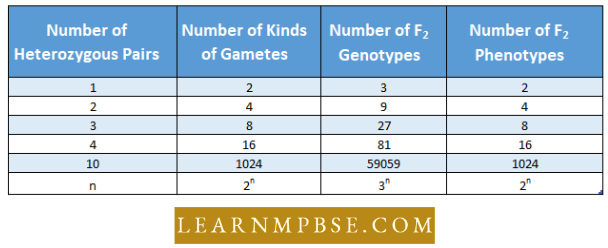
Self Stecrility: Hound in plants having multiple alleles for compatibility incompatibility reaction – S1, S2, S3, S4, S5, S6, etc. A plant carries two such allelesExample S1, S2, S2, S3, S1, S3,S2,S4,S3,S5.
- A pollen grain carries only one allele. If it happens to be one of the two alleles of the pistil, the pollen grain fails to form a pollen tube.
- Heterodominance or Overdominance or Superdominance: Scrra( 1959) described when F1 generation heterozygotes have a more complex phenotype than that of a corresponding parent, it is termed hetero-dominance.
F1 Generation: The F1 or First filial (Filus — son and filial—daughter) generation is the generation of hybrids produced from a cross between two genetically different individuals called parents as Tt individuals are produced from a cross between TT and tt parent.
F2Generation. F2 or Second filial generation is the generation of individuals which arises as a result of inter-breeding amongst individuals of the F1 generation.
- Principle of Paired Factors. Each character is represented in an individual by two determinants, factors or genes. They are similar in homozygous individuals which breed true. The factor or a character represents two alternatives of a trait in hybrids.
- Monohybrid Cross: It involves the study of the inheritance of one pair of contrasting characters.
- Monohybrid Ratio: It is the ratio obtained in the F2 generation when a monohybrid cross is made and the offspring of the F1 generation are self-bred. Monohybrid ratio is usually 3 :1 (phenotypically) and 1: 2 :1 (genotypically).
- Dihvbrid Cross: It is a cross between two organisms of a species which is made to study the inheritance of two pairs of characters.
Trihybrid Cross: A cross between homozygous parents that differ in three gene pairs (i.e. producing trihybrids) is a combination of three single-pair crosses operating together. Thus (AA x aa), (BB x bb) and (CC x cc) could be combined in the same cross.
Principles Of Inheritance And Variation NEET Notes
- Dihybrid Ratio: It is the ratio obtained in the F9 generation when a dihybrid cross is made and the offspring of the F1 generation are self-bred. Phenotypically it is 9:3:3:1.
- Trihybrid ratio: Ratio in F2 obtained in a trihybrid cross represented by a Punnet square. 64 (8n) squares would be required with a phenotypic ratio of 27:9:9:9: 3:3:3:1.
- Polyhybrid Cross: It includes those characters in which inheritance of more than two pairs of genes are considered.
- Reciprocal Crosses: These crosses involve two concerning the same characters but with reversed sexes. It means if in a first cross, A is used as the female parent and B as the male parent, then in 2nd or reciprocal crosses A will be used as the male parent and B as the female parent.
Punnet Square: It is a chequerboard used to show the results of a cross between two organisms. The chequerboard was devised by R.C. Punnet. It depicts both the genotype and phenotype of the progeny.
- Dihybrid: An individual that is heterozygous for two pairs of alleles. The progeny of a cross between homozygous parents differs in two respects.
- Homozygous: The condition in which only one allele of a pair is present, as in sex linkage or as a result of deletion.
The formula for number of genotypes in case of multiple alleles is \(\frac{n}{2}(n+1)\) = n Alleles. i.e. in the case of the blood group system, 3 alleles regulate the ABO blood group thus number of the genotype formed will be six.
- If a cross is made between two yeasts having genotype Aa Bb Cc. then the probability of getting genotype aa bb cc will be 1/64 because if we consider individuals the probabilities of occurring of aa, bb and cc is — \(\frac{1}{4}\) therefore = \(\frac{1}{(4)^3}=\frac{1}{64}\)
- Three genotypes are produced by two alleles.
- Even Aa Bb Cc DD Ee Ff produces 32 different gametes.
- A recessive allele in the zygote appears only if both parents possess this allele.
- Progeny = offspring ir
- Siblings or sibs, Individuals having the same parents, brothers and sisters.
Mendelian Inheritance NEET
NEET Biology Principles Of Inheritance And Variation Modifications Of Mendelian Ratio And Gene Interaction
Gene interaction. It is the influence of one gene (allele) over another which causes a change in expression, and phenotype of normal Mendelian ratios like 3: 1 (monohybrid cross) and9:3:3:l(dihybrid cross.).It may be intragenic (intr alleles) or intergallic (non-allelic). They are of the following types :
- ID Incompletedominance (Intermediateinheritance). It is the phenomenon where none of the two Mendelian factors, alleles or genes is dominant over the other.
- Genotypic and phenotypic ratios are the same in the F2 generation i.e. 1:2:1. Example. Illustrated in Mirabilis jalapa (Four o’clock), Antirrhinum (Snapdragon or Dog flower) and Andalusian fowls.
- In a dihybrid cross if one trait follows the law of dominance the other shows incomplete dominance, the ratio comes to be 3: 6: 3:1 : 2: 1 and if both traits show incomplete dominance, it will be1: 2:1: 2: 4: 2: 1.
- Codominance. It is the equal and independent expression of two alleles of a trait when they are present together in an individual. The phenotype of a heterozygous individual is different from either of the homozygous.
- Example. A, B, AB and O blood group.
Genetic Disorders And Variation NEET
Duplicate Genes (15: 1) Observed by G.H. Shell Pseudoalleles or Duplicate genes or factors are two or more independent genes present on different chromosomes which determine the same or nearly the same phenotype in a dominant state so that either of them can produce the same character. The independent genes do not have a polymetric effect, e.g. Endosperm colour in maize, fruit shape in Shepherd’s’ purse, and inheritance of grain colour in Avena sativa (Oat).
- Polymetric or Additive genes (9:6: 1). They are duplicate genes with cumulative effects. Two independent dominant genes, whether present in homozygous or heterozygous conditions have similar phenotypic effects when present individually but produce a cumulative or double effect when found together for example Summer squash plant (Cucurbita pepo) has three types of fruit forms.
Polygenes (Quantitative inheritance) or Multiple genes or Cumulative genes. There are many characteristics in both plants and animals which are controlled by the cumulative action of dominant alleles of generally two or more independent genes for example., height, weight, size of fruits, number of grains in an ear, skin colour in mah.
NEET Principles Of Inheritance And Variation Chapter Notes
Illustrations of Polygenes in Human Skin Colour
- Human skin colour is controlled by the polygenic effect of at least three separate genes.
- Each gene contributes to a unit of darkness’ due to incomplete dominance. ‘
- Skin colour is determined by cumulative genes and this hypothesis was designed by Davenport and Davenport in 1910.
- Davenport and Davenport designated five phenotypic classes controlled by genes A . and B (like kernel colour of wheat)
Hughes (1944) recognized seven phenotypic classes designating genes A, B and C.
- The skin shades vary from very dark in AABBCC individuals to very light in an aabbcc individual.
- A person with AaBbCc (i.e. heterozygous for all three genes) will have an intermediate colour termed mulatto.
- The number of possible allele combinations in the gametes is eight (ABC, ABc, AbC, aBC, abC, aBC, abe. abc) for such a person.
- So a total of 64 phenotypic combinations is possible when two persons of ABC x abc gene combinations marry.
Genetic Disorders And Variation NEET
NEET Biology Principles Of Inheritance And Variation Characteristics Of Polygene
- Negligible effect of environment.
- No involvement of linkage and epistasis.
- The quality of the gene does not matter.
- Each contributing gene (allele) in a series produces an equal effect.
- The effect of each contributing gene is additive (cumulative).
Short Cut Method To Predict The Phenotype Ratio Of Polygenic Inheritance :
- We should know the numbers of total alleles involved in a quantitative inheritance to predict the phenotype ratio of F-, generation.
- This prediction can be shov/n with the help of Pascal’s triangle: e.g. Kernel colour of wheat there are 4 alleles and a ratio of 1: 4 : 6: 4: 1 is obtained.
- Nilsson-Eble (1908) obtained the first experimental proof of polygenic inheritance.
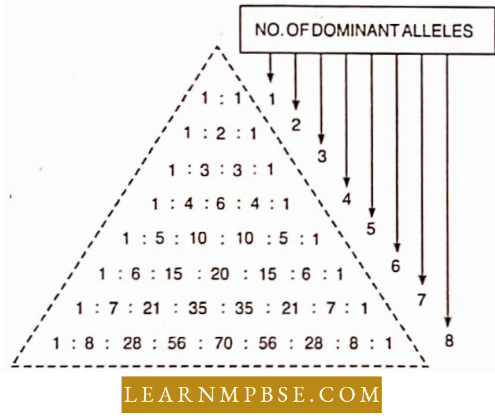
Dihybrid And Monohybrid Cross NEET
Some Ratios Of Polygenic Inheritance:
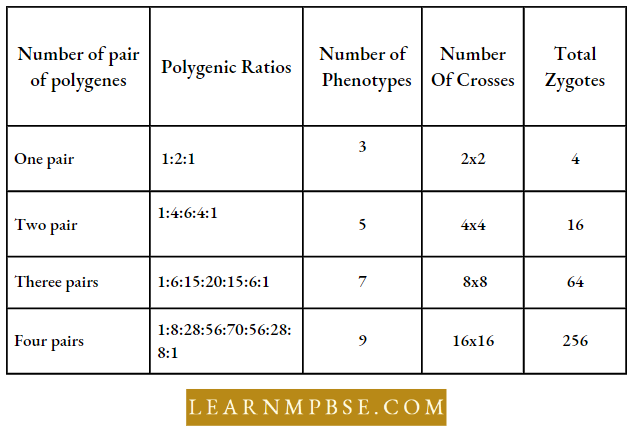
Quantitative or polygenic inheritance was first studied by J. Kolreuter in the case of tobacco and F. Galton in the case of human beings, Nilsson-Ehle in kernel colour in wheat and Emerson and East studied it in cob length in maize. Davenport studied skin colour in man
The relative contribution of each polygene
= \(\frac{\text { Maximum height }- \text { minimum average height }}{\text { Total number of polygenes }}\)
- Complementary genes (9:7) (Bateson and Punnet 1906). These non-allelic genes independently show a similar effect but produce a new (rail when present together in dominant form for example., flower colour in sweet pea, grain colour In lice, grain colour in Sorghum.
- Supplementary genes (9:3: 4): They are a pair of non-allelic genes; one of which produces its effect independently when in the dominant state while the dominant allele of the other is without any independent effect but can produce a new trait along with the dominant allele of the form example Glume colour in Sorghum emulation, Seed colour in Lab lab, Coat colour in mice and guinea pig.
- Collaboration: Epistasis of complementary and supplementary genes produces a ratio of 27: 37. c.g. Maize colour pigment anthocyanin is due to two complementary genes and one supplementary gene.
Principles Of Inheritance And Variation Class 12 Notes For NEET
Epistasis: It is the phenomenon of masking or suppressing the expression of a nonallelic gene. The gene which suppresses other non-allelic genes is called the epistatic gene while the gene or locus which is suppressed by the non-allelic gene is called the hypostatic gene.
- Dominant epistasis (12: 3:1): The dominant allele at one locus suppresses the expression of another gene regardless of its allelic condition ( dominant or recessive)Example Fruit colour in cucurbita (yellow, green and white), coat colour in the dog (White, black and brown).
- Recessive epistasis (9:3:4): In this case, recessive homozygous genotype at one locus (aa) suppresses the expression of non-alleles at another locus. The latter can produce their effect only when a dominant allele occurs at the first example Pigmentation in onion bulb, and coat colour in mice.
- Dominant-recessive epistasis (13 : 3): Here the dominant allele at one locus (A-) and recessive allele at another locus (bb) give rise to the same effect. (A-B, A-bb, aabb) other gene combinations produce different phenotypesExample Plumage colour in poultry birds.
Summary Of Epistatic Ratios:
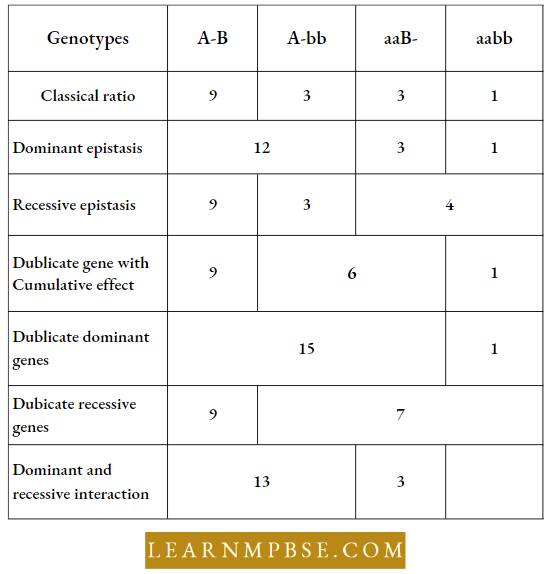
Lethal genes. These genes kill the organism when they can express their effect. Dominant or homozygous recessive, for Example, Sickle cell anaemia, Fur colour in mice (first studied by Cuenot in 1905)
Dihybrid And Monohybrid Cross NEET
- E. Baur. Observed lethal genes in. Snapdragon (Antirrhinum) ill Yellow Lethals in Mice
- Lucien Cuenot (1905) reported an incompletely dominant allele Y for yellow coats in mice.
- ‘A’ represents a gene for yellow and ‘n’ one for black.
- W. Castle and C. Little (1910) proposed that the yellow homozygotes were aborted in the uterus.
- In other words, the yellow allele has a dominant effect on coat colour but acts as a recessive allele concerning the lethality phenotype.
Albinism In Corn (Zea mays)
- Albinism in corn is due to a lethal gene.
- The gene ‘G’ is for normal chlorophyll production. It is completely dominant to its allele.
- G plants contain chlorophyll and are photosynthetic.
- On the other hand, gg plants produce no chlorophyll and are yellowish white and die.
Pleiotropic Genes: These genes have multiple effects because they influence several traits simultaneously.
Examples
- Marphan’s syndrome is caused in human beings by a pleiotropic gene which is characterised by a slender body, limb elongation, hypermobility in joints, lens dislocation and a tendency to develop heart diseases.
- Sickle cell anaemia. Sickle cell anaemia disease is caused by gene (Hbs) which is lethal in the homozygous condition but has a slightly detectable effect in the heterozygous condition. In sickle cell anaemia, a change in the shape of red blood cells occurs in the venous blood.
Being deficient in oxygen tension, these erythrocytes show a marked change in their structure attaining a sickle-shaped structure. As a result, rupturing of cells may take place and chronic haemolytic anaemia is caused.
- This disease is caused when the gene responsible for haemoglobin produced by recessive alleles differs in one amino acid i.e. it incorporates valine in place of glutamic acid, at the 6th position of the β-chain.
- Sickle cell anaemia is common in persons of African descent and is also found in some other parts of the world where malaria is, or has been major cause of death.
- In heterozygotes HbAHbS, some red cells contain haemoglobin A, and other haemoglobin S. Because both types of haemoglobin, rather than a single intermediate form are produced, it is also a case of codominance.
- Under normal conditions, heterozygotes manifest none of the severe symptoms of HbsHbs persons, though they may suffer some periodic discomfort and even develop anaemia after a time at high altitude.
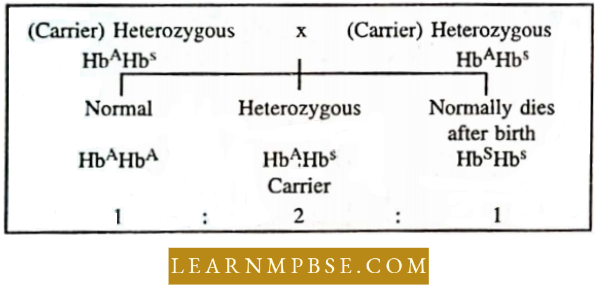
Principles Of Inheritance And Variation Class 12 Notes For NEET
Explanations for various genotypes are :
- HbAHbS — Normal (Haemoglobin A only: no sickling)
- HbAHbS — Sickle cell trait (Haemoglobin A and S: sickling under reduced oxygen tension)
- HbSHbS — Sickle cell anaemia (Haemoglobin S only: sickling under normal oxygen tension)
Sickle cell anaemia can also be considered a case of lethal genes.
- A lethal gene can be defined as a gene whose phenotypic effect is sufficiently drastic to kill the bearer.
- The expected ratio in lethal gene cases comes equal to 2: 1.
- In sickle cell anaemia, death is caused by HbSHbS condition.
Multiple Alleles:
Genes possessing multiple alternative forms, such as 15 alleles for eye color in Drosophila.
- Four alleles determine coat colour in rabbits. ABO blood groupings.
- Multiple alleles exhibit the following characteristics
- Several alleles are situated at the identical locus on the chromosome.
- Several alleles govern a specific trait.
- Crossover events do not occur across multiple alleles since they occupy the same locus.
- Multiple alleles can exhibit dominant or intermediate traits, but the wild type in the series is often dominant.
- Wild type or dominant alleles are denoted by uppercase letters, whereas recessive alleles are indicated by lowercase letters
Blond groups:
Viv determined by two types of antigens (A and B) present on the surtax coating to R.B.C.These antigens occur in the oligosaccharides-rich head regions of a glycophorin.
Principles Of Genetics NEET Notes
Showing phenotype, genotype and antigen.
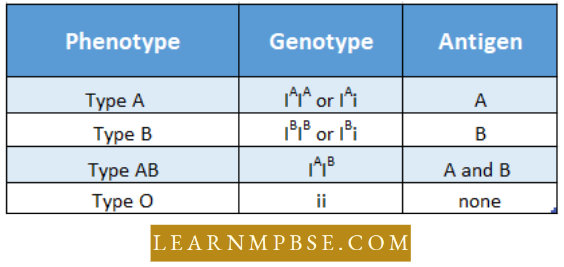
- Additive Factors: Polygenes affecting the same trait, with each enhancing the phenotype.
- Concordance: Identity of matched pairs or groups for a given trait; for example, identical twins both expressing the same genetic syndrome.

NEET Biology Principles Of Inheritance And Variation Revision Notes
NEET Biology Principles Of Inheritance And Variation Important Contributors
E. Haeckel:
Inheritance transmission via the nucleus.
- Pythagoras: He posited the hypothesis of moist vapour.
Empedocles proposed that each bodily portion generated a fluid, so introducing the fluid theory of inheritance. - Aristotle proposed the hypothesis of reproductive blood.
- Darwin posited that each somatic cell and tissue in the body generates minute particles known as gemmules or pangene, which encapsulate both hereditary and acquired traits.
- Leeuwenhoek: First observed spermatozoa.
- Malpighi posited that a homunculus, or miniature individual, exists within sperm or egg cells.
- Maupertuis proposed the notion of pangenesis, positing that heredity is governed by minute particles.
- Kolreuter, a German botanist. He produced viable interspecific hybrids in tobacco. He is the ‘‘father of polygenic inheritance.”
Gregor Johann Mendel. Father of genetics as he was the first to demonstrate the mechanism of transmission of characteristics and biochemical disorders of man.
- Johannsen. Coined the terms gene and genotype, phenotype and pure line.
- Gallon. Started pedigree analysis.
- R.C. Funnel. Used a chequerboard called Punnet square to show the results of a cross between two organisms.
- Sir Archibald Garrod. Studied ABO blood types.
- F. Gallon. He studied polygenic inheritance in man and coined the term eugenics.
- Nilsson-Ehlc. Obtained the first experimental proof of polygenic inheritance in the case of kernel colour of wheat.
- Karl Landsteiner. (1907) discovered A. B, O blood groups.
- Gastello and Steini (1902) discovered the A B blood group.
- Kolreuter: (German botanist). He obtained fertile interspecific hybrids in tobacco. He is the “father of polygenic inheritance.
- Karl Landsteiner and Weiner discovered the Rh Factor.
- Corrrens, de Vries and Tsechermak rediscovered Mendel’s theory ol inheritance. Also discovered incomplete dominance and cytoplasmic inheritance.
Principles Of Genetics NEET Notes
NEET Biology Principles Of Inheritance And Variation Some Important Ratios
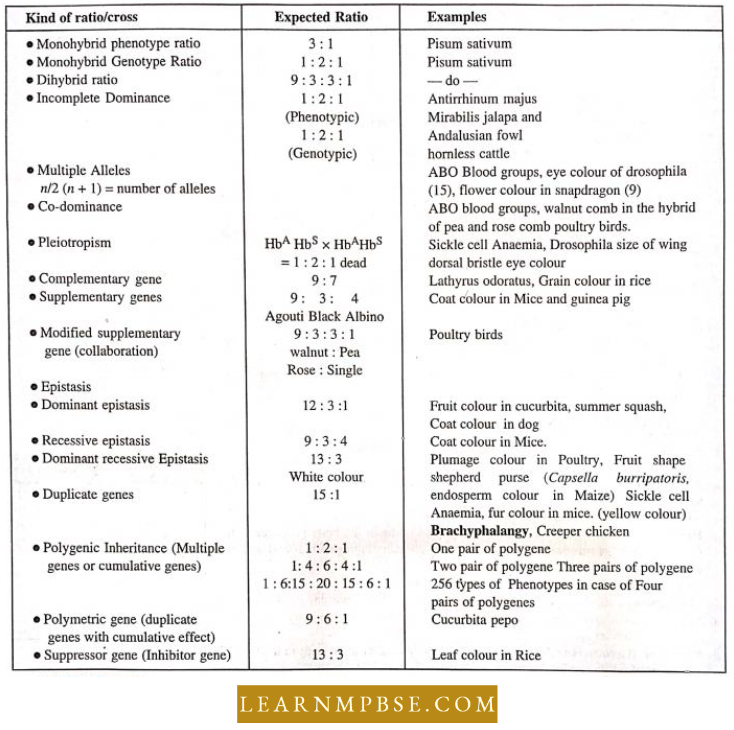
Principles Of Genetics NEET Notes
NEET Biology Principles Of Inheritance And Variation Variations
All living beings exhibit variations in practically every character and almost all directions.
- The differences shown by the individuals of a species also by the offspring of the same parents are referred to as variations.
- All organisms change themselves to adapt themselves to the changing environment, otherwise they fail to survive. Variations are classified in two ways i.e.
As per the nature of the cells, it affects.
Somatic variations. Such variations are not inherited from parents and affect the omalic cells only.
- They are acquired by an organism during its lifetime and are lost with death Hence, such variations are also called acquired variations. There are possible causes for such variations :
Three possible causes of acquired variations are :
- Environmental Factors i.e. medium, light, temperature, nutrition and water.
- Use of disuse of organs
- Conscious efforts
Germinal variations (Blastogenic Variations). These variations cause the line to grow cells and are thus inheritable for haemophilia, blood groups, colour-blindness, hairiness, eve vvIihii etc SikIi satiations may be due to the following reasons. As per the degree of difference produced. 2 types
- Merstic = Influence the mnnlicr of parts
- Substantive = Inllncnec the shape, size, weight and colour.
Continuous sanctions: Variation not represented by distinct classes. Individuals grade into each other and measurement data are required for analysis (cf. Discontinuous variation), Multiple genes or polygenes are usually responsible for Ibis type of variation, (or Fluctuating variations).
- Discontinuous variations. Distinct classes such as red versus white, tall versus dwarf (rf. Continuous variation).
- Transgressive variation. The appearance in (lie F2 (or later) generation of individuals, showing n more extreme development of a trait than shown in either original parent. It is due to polygenic inheritance discovered by Punnet and Hailey.
- Determinate Variations (Orthogenic variation). Adaptive and selective variations of definite evolutionary lines, developing progressively generation after generation.
- Indeterminate variations. Variations occurring in any conceivable direction and are not governed by any law may give a distinct advantage to the possessor in its light for existence.
Techniques Used To Study Lutinuii Genetics
- Pedigree analysis
- Population genetics
- Human karyotype.
Pedigree analysis: Pedigree is a record of the inheritance of certain traits for two or more generations presented in the form of a diagram family tree or symbols. Different symbols used are.
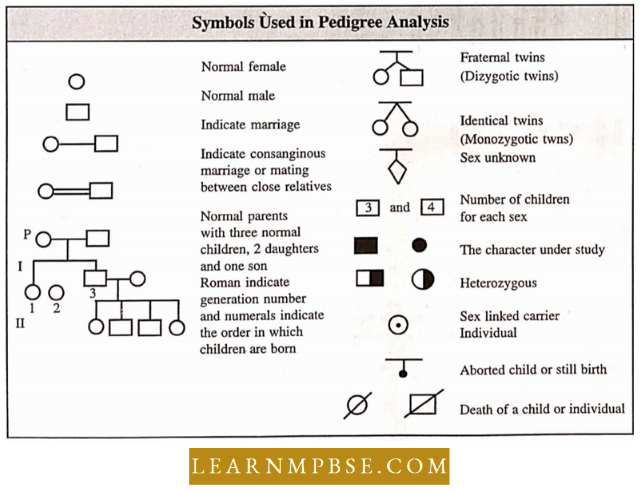
- The idea dial disorders are inherited has been prevailing in human society for a long. Dus was based on the heritability of certain characteristic features in families.
- After the rediscovery of Mendel’s work, the practice of analysing the inheritance patterns of traits in human living began.
- Since it is evident that control crosses that can be performed in plants or some other organisms, are not possible in the case of human beings, the study of the family history about inheritance of a particular trail provides an alternative.
- Such an analysis of traits in several of generations of a family is called the pedigree analysis. In the pedigree analysis, the inheritance of a particular trait is represented in the family tree over generations.
- In human genetics, pedigree study provides a strong tool, which is utilised to trace die inheritance of a specific trait, abnormality or disease.
Population genetics:
- It is the study of the distribution of units and the frequency of genes within the total population.
- The formula delineating the genotypic expectations of progeny in relation to the gametic (allelic) frequencies of the gene pool was proposed by Hardy and Weinberg and is referred to as the Hardy-Weinberg principle.
Principles Of Inheritance And Variation NEET Notes
This law is applicable only if:
- Populationis is large and pamniclie (Random matiing).
- No selecting, no imitation.
- Population is closed.
under these conditions, according to Hardy and Weinberg’s Law. there.should be no change in the gametic or zygotic frequencies from generation to generation.
Expected genotype pic (zygotic) frequencies in generations may be summarised as
⇒ (p+q)2=P2+2pq+q2=1.0
⇒ P2 = frequency of dominant gene/alleles.
⇒ q2 = frequency of recessive gene/alleles P=k=1
⇒ p2 + 2pq = frequency of dominant trait.
⇒ q2 = frequency of a recessive trait.
Human Karyotype: Tjio and Levan first prepared a human karyotype.
- It is an arrangement of chromosomes according to the length of chromosomes and the position of the centromere.
- A pencil sketch or photograph of a karyotype is called an idiogram.
- It is an asymmetrical karyotype which is considered an advanced character.
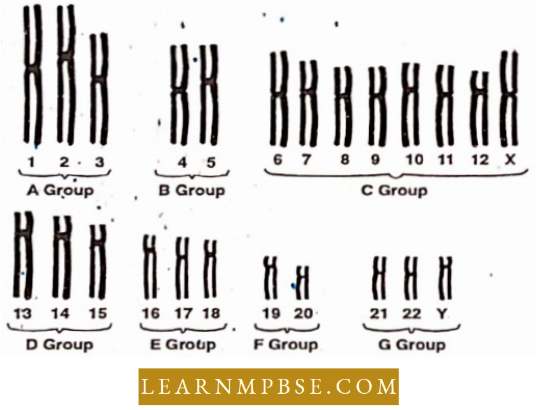
Principles Of Inheritance And Variation NEET Notes
Classification of chromosomes: The human metaphase chromosomes were First of all classified in a conference of cytogeneticists at Denver, Colorado in I960.
- In humans 23 pairs (46) chromosomes have been numbered from l to 23 according to their decreasing size, Patau (I960) divided the human chromosome into the following seven groups designated A to G.
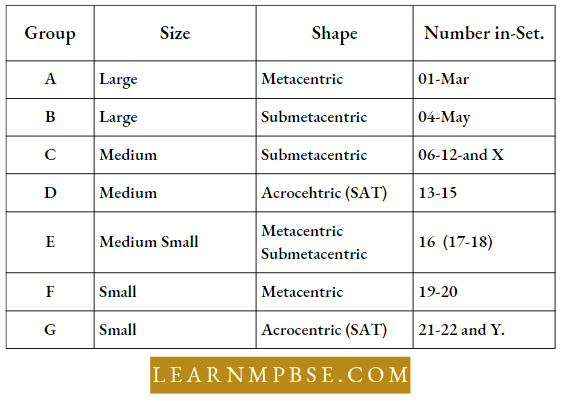
- Banding Technique: It is the development of risk ami light band of stains on the chlorosome when they are treated with special fluorescent lives.
- Hits are because different parts of the chromosome show differential affinity to these stains.
- Chromosome handling was discovered by Caspersson et al (1970) and Paridue and Galt(1970) almost simultaneously late as different types of stains and staining techniques.
- Each develops a unique banding pattern which remains constant.
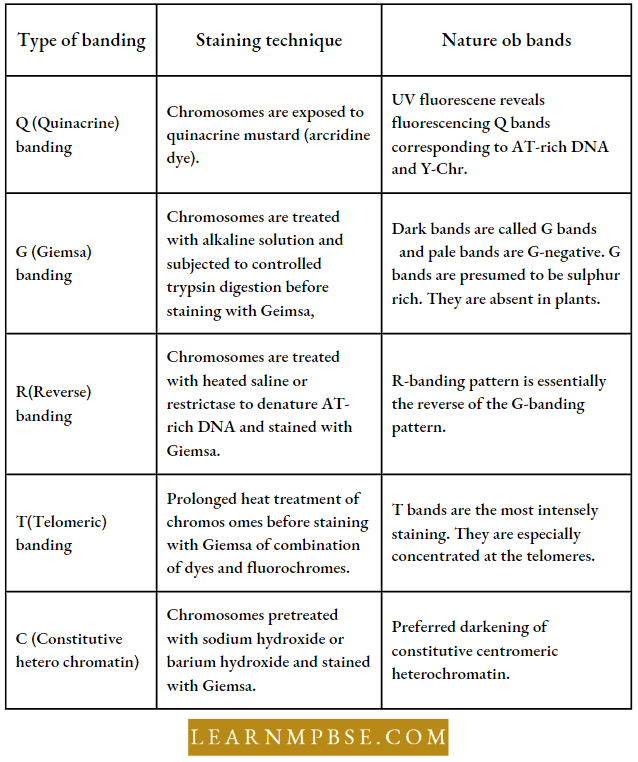
Mendelian Inheritance NEET
- Continuity of life is made possible by asexual and sexual reproduction Sexual reproduction, besides creating new individuals introduces variability in the offspring by combining trials of parents.
- The genotypic ratio of the dihybrid cross is RRYY: RrYY : RRYy: rrYY: RrYy : rrYy: ItRyy : Rryy: rryy 1:2: 2:1:4:2:1:2:1
- In the case of MN blood groups in humans, alleles show codominance. The red blood cells can carry two types of native antigens, M and N, and an individual can be MM, MN or NN exhibiting either one or both of them
- ABO blood group system shows codominance, multiple alleles and dominant recessive gene interaction.
- Treatment with gibberellic acid only brings phenotypic changes and genes are not affected.
- Pleiotropy results in different expressions at the phenotypic level. For example, sickle cell anaemia and cystic fibrosis in men.
- Morgan is called the father of experimental genetics. Bateson is called the father of modern genetics. Nilsson-Ehle (1908) was the first scientist to prove quantitative inheritance.
- At the time of fertilization, the chance factor is responsible for the fusion of gametes. Infinite new combinations are produced Example 70 × 1012 for 23 pairs of chromosomes.
Cause Of Variations Is Hidden In Sexual Reproduction
Mendel’s Laws of Inheritance:
- Law of paired factors
- Law or Principle of Dominance Law of Segregation.
- Phenotypic ratio = 3:1 Monohybrid genotypic ratio =1:2:1
- Law of Independent assortment Dihybrid phenotypic ratio = 9 : 3 : 3: 1 Dihybrid genotypic ratio = 1: 2 : 1: 2 : 4: 2 : 1: 2: 1
Exceptions To Mendelism
- Incomplete Dominance = Genotypic and phenotypic ratio =1:2:1
- Codominance. IAIA (In the case of blood groups)
- HbAHbA (In case of sickle cell anaemia)
- Multiple alleles. 15 alleles for eye colour in Drosophila, 3 alleles for blood groups in humans (IA, IA and 1° for four types of blood groups (A, B, AB and O.)
- Chromosomal theory of inheritance proposed by Sutton and Boveri (1902)
- Experimental verification by Morgan with his experiments on Drosophila melanogaster.
- Linkage. Physical association of two genes on a chromosome.
- Recombination. Generation of non-parental gene combination.
- Sex Determination.
Genetic Disorders And Variation NEET
Human : Autosomes + XY → Male, Autosomes + XX → Female
Most of the insects (Male heterogamy).
- Grasshopper AA + XO → Male
- AA + XX → Female
- Birds AA + ZW → Female
- AA + ZZ → Male
Mutation
- Chromosomal mutation
- Point mutation — Sickle cell anaemia
- Frameshift mutation.
Mutagen—Physical agents which cause mutation: UV radiation and Chemical Mutagen.
Pedigree Analysis Male and Female Analysis of Traits.Marriage between close relatives 0=0

NEET Biology Principles Of Inheritance And Variation Study Material
NEET Biology Principles Of Inheritance And Variation Elements Of Heredity And Variations Conclusion
In sickle cell anemia, glutamic acid is substituted by valine at the sixth position in the β-chain of haemoglobin.
- In thalassemia, a genetic blood condition characterized by anemia, the β-chain of haemoglobin is altered due to a frameshift mutation. Bone marrow is absent.
- Either the mother must be Rh positive, or both the mother and the husband must be Rh negative; otherwise, the second kid may suffer erythroblastosis fetalis.
- Rh positive is genetically prevalent in humans.
- The back cross is a genetic cross formulated by Mendel in which the F1 generation is mated with an individual possessing the same genotype as one of the parental organisms.
- The colouration of sweet pea flowers is attributed to a substance known as anthocyanin. It is released by a sequence of metabolic processes involving distinct enzymes.
The formation of each enzyme is determined by separate genes the mutant white tigers now seen in Indian zoos, a defective pleiotropic gene influences both fur colouration and the connection between the eye and brain during development.
- The trihybrid ratio shows the same pattern of inheritance as the dihybrid. The phenotype ratio will be 27: 9 : 9: 9 : 3 : 3 : 3: 1.
- When the heterozygotes have a more extreme phenotype than either of the corresponding homozygotes, then it is usually called over-dominance, super-dominance and hetero-dominance.
- Parasexual hybridisation. It is defined as the technique of hybridisation through protoplast fission. The protoplast fusion opens up the possibility of overcoming the sexual barriers and of mixing and reassorting the genetic element of sexually isolated organisms
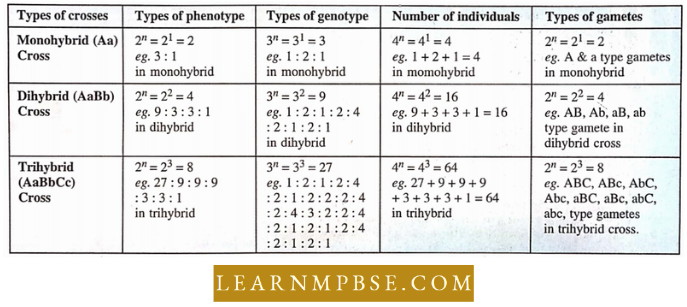
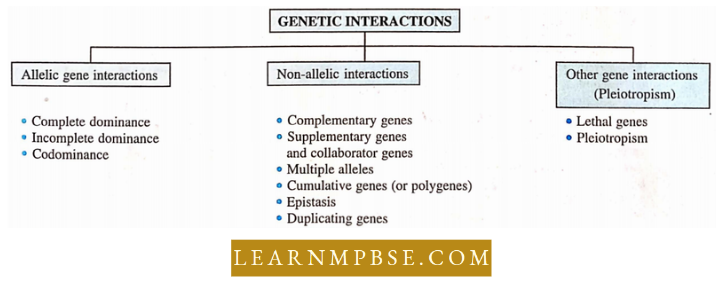
- Mendel used the word unit factor or pair factors for controlling units by various traits because he was unaware of the word gene.
- Epistasis is a Greek word which means the act of stopping or inhibiting.
- Non-allelic genes are those present in different loci.
- Genealogy: The history of descent of a person or its family is termed genealogy.
- Modifier Genes: Genes that alter or modify the expression of other non-allelic genes. Modifier genes produce a variety of crests on pigeons’ heads.
